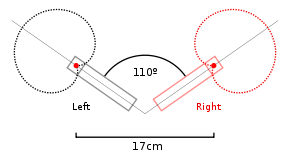
ORTF stereo technique
Encyclopedia
The ORTF stereo microphone system is a microphone
technique used to record stereo sound.
 It was devised around 1960 at the Office de Radiodiffusion Télévision Française (ORTF) at Radio France
It was devised around 1960 at the Office de Radiodiffusion Télévision Française (ORTF) at Radio France
.
ORTF combines both the volume difference provided as sound arrives on- and off-axis at two cardioid
microphones spread to a 110° angle, as well as the timing difference as sound arrives at the two microphones spaced 17 cm apart.
The microphones should be as similar as possible, preferably a frequency-matched pair of an identical type and model.
The result is a realistic stereo field that has reasonable compatibility with mono playback. Since the cardioid polar pattern rejects off-axis sound, less of the ambient room characteristics are picked up. This means that the mics can be placed farther away from the sound sources, resulting in a blend that may be more appealing. Further, the availability of purpose-built microphone mounts makes ORTF easy to achieve.
As with all microphone arrangements, the distance and angle can be manually adjusted slightly by ear for the best sound, which may vary depending on room acoustics, source characteristics, and other factors. But this arrangement is defined as it is because it was the result of considerable research and experimentation, and its results are predictable and repeatable.
These interchannel differences are not the same as interaural differences, as produced by artificial head recordings. Even the spacing of 17 cm is not strictly based on interaural ear spacing. The recording angle for this microphone system is ±48° = 96°.
Microphone
A microphone is an acoustic-to-electric transducer or sensor that converts sound into an electrical signal. In 1877, Emile Berliner invented the first microphone used as a telephone voice transmitter...
technique used to record stereo sound.

Radio France
Radio France is a French public service radio broadcaster.-Mission:Radio France's two principal missions are:* To create and expand the programming on all of their stations; and...
.
ORTF combines both the volume difference provided as sound arrives on- and off-axis at two cardioid
Cardioid
A cardioid is a plane curve traced by a point on the perimeter of a circle that is rolling around a fixed circle of the same radius. It is therefore a type of limaçon and can also be defined as an epicycloid having a single cusp...
microphones spread to a 110° angle, as well as the timing difference as sound arrives at the two microphones spaced 17 cm apart.
The microphones should be as similar as possible, preferably a frequency-matched pair of an identical type and model.
The result is a realistic stereo field that has reasonable compatibility with mono playback. Since the cardioid polar pattern rejects off-axis sound, less of the ambient room characteristics are picked up. This means that the mics can be placed farther away from the sound sources, resulting in a blend that may be more appealing. Further, the availability of purpose-built microphone mounts makes ORTF easy to achieve.
As with all microphone arrangements, the distance and angle can be manually adjusted slightly by ear for the best sound, which may vary depending on room acoustics, source characteristics, and other factors. But this arrangement is defined as it is because it was the result of considerable research and experimentation, and its results are predictable and repeatable.
These interchannel differences are not the same as interaural differences, as produced by artificial head recordings. Even the spacing of 17 cm is not strictly based on interaural ear spacing. The recording angle for this microphone system is ±48° = 96°.

